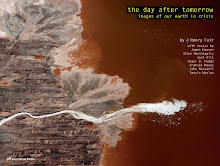
So often in doing my aerial shoots, I have no previous specific knowledge of my subject matter. Research on the images typically follows each shoot. In this case, I had three experts with me who were able to tell me all of the particulars, for which I am always so hungry. Our pilot, Michael Hanke, specializes in flying humanitarian and environmental expeditions. He is a sure-handed pilot who does his job so well that one could almost think he looks careless; Karsten Smid is a Greenpeace energy expert on brown coal issues, particularly as it relates to these locations; finally, the writer from the Taz, Nick Rymer, worked in a factory directly in the region of the mines and power plants and has a personal inside knowledge of these places.
We headed south from Berlin to the Lausitz/Cottbus mining site. The extent of the devastation in this area is amazing. That we humans could so heedlessly destroy such vast areas is audacious. The impact is all-encompassing, from the displacement of local populations to the massive carbon emissions (some of the plants we saw were among the largest carbon emitters in Europe).

Let’s not forget the inefficiency of lignite; such a poor energy source that it’s only worth mining if it’s burned directly where it is mined. Hurrah for the Berliners who are taking a stance against the burning of lignite by specifying that they want to purchase power from “green” sources, a movement only in the nascent stage in the USA. Burning coal is completely crazy. The rant begins by noting that there are myriad options without the consequences that accompany lignite, which are too many to list, but a few include: largest single cause of global warming and acid rain, greatest cause of mercury in the environment (meaning the fish we eat), single main producer of radioactive material released into the air and water. This just begins the list of reasons why mining and burning lignite make absolutely no sense. The only reason why we continue this ridiculous practice is that a few people are making a lot of money, as they are burning our future in the process. End rant.
Soon, the devastation at Janschwalde comes into view. I will admit that my head was nodding as I had only slept about 4 hours in the last 30, but the looming subject brought me back to life. These areas are vast, and we are inured to it because of our jaded media overload. Imagine if you were forced to move from your house so someone could burn the ground underneath it to make a lot of money and pollute the planet. The operations are owned and run by a Swedish company forbidden from coal operations at home, but happy to do it in these outback regions of old East Germany. Is it true that one of the chief executives of the company is the “climate advisor” to the reigning government? The operations are enormous, and efficient in the typical German way. Machines the size of which you can’t imagine move volumes of earth from one place to another to expose the layers of coal so different machines can scoop the coal onto a conveyor where it goes to be burned. All of this is powered by electricity, so in some sense this is just a machine devouring the earth to feed itself.
I will admit to a fascination with these machines, the largest built by humans, ironically contributing to our own destruction. They have a beauty of elemental function that makes them art in a certain way.
---
The machine that actually digs the coal is rather small compared to the rest, and sits at the bottom of this tremendous moving trench. Most of my images are of the machines that move the “overburden,” and of course, the abstractions of the devoured earth, which only I can seem to capture. The final waste products (in this case, ashes and smoke) are always things I seek, and as usual, they are illuminating. Interactions of industrial nightmares with groundwater or the water table are a story worth telling in all cases, and here especially. Of course I am a visual artist, so the story I look to tell is a visual one. I can research the facts behind the storyline, but the goal here is citizen participation. We must all drink the water and breathe the air.
We find a place where the ashes are pumped into a gulch, mixing with the surface water to produce a beautiful, nightmarish lake with patterns of flow and color variations. I have the pilot circle repeatedly, certain that the scientists and reporters are convinced of my insanity…





